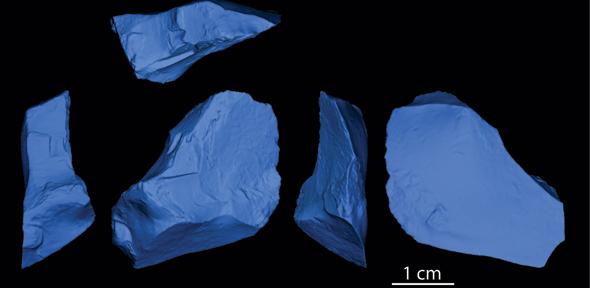Now, a team of archaeologists have dated a number of stone tools excavated recently from the same site to 43,500 years ago. Results show they were part of the Aurignacian culture, which is generally accepted as indicative of modern human presence. It is agreed that modern humans dispersed into Europe, and began to replace Neanderthals, at least 40,000 years ago. The new research pushes this date back to a potentially much earlier time when temperatures north of the Alps were cool.
The stone tools, excavated between 2006 and 2011, include small ‘bladelets’, which were originally part of composite tools and may have been used as projectile points. Using stratigraphy and radiocarbon dating, the researchers demonstrated that the finds date to 43,500 years ago – making them significantly older than other known Aurignacian artifacts, which have been found all over Europe.

One of the stone tools found recently at Willendorf. Credit: Philip Nigst/Willendorf Project
“The recent finds indicate a modern human presence and the date of the artefacts represents the oldest well-documented occurrence of modern humans in Europe,” said Dr. Philip Nigst of the University of Cambridge. The study reveals that modern humans were living in the region that is now Austria at the same time that Neanderthals were living in other parts of Europe and that modern humans and Neanderthals shared this region for longer than previously thought.
“The Willendorf finds strongly suggest that modern humans and Neanderthals met and interacted, and may well have exchanged both mates and ideas,” said Nigst. “The picture emerging from our study is fascinating because we see significant changes in the material culture of the last Neanderthals – and these changes occur at the same time that modern humans were present at Willendorf. The timing of these events cannot be a coincidence.”
Analysis of the type of soil in which the tools were found, reveals that the tools were in use during an era when the climatic conditions were cool with a steppe-like environment with conifer trees distributed along river valleys.
“Our results suggest that the early modern human settlers, who are thought to have come to Central Europe from the warmer environments of southern Europe, did so in a cool steppe-type climate. Previous studies have suggested that modern humans moved into Western Europe during either a very cold phase or during a warmer temperate phase,” said Nigst.
“Our study shows that early modern human settlers in Central Europe were resilient to a variety of environmental conditions. Rather than tracking a particular environment, they coped very well with a wide diversity of environments, each one requiring a different subsistence strategy.”
Source: University of Cambridge




Comments